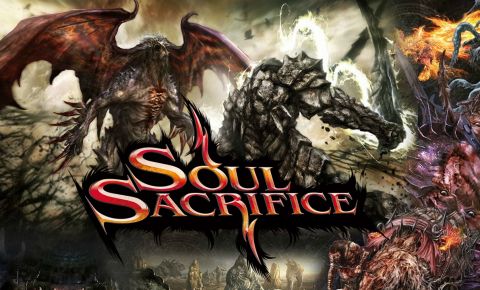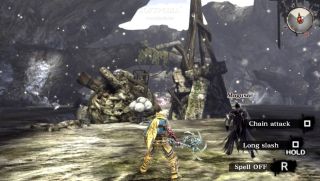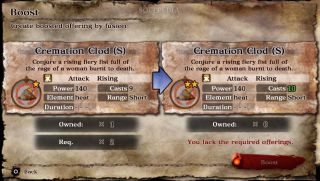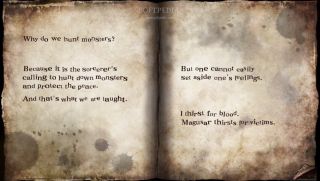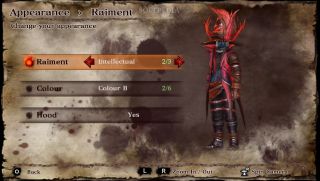Soul Sacrifice is a PlayStation Vita exclusive Japanese action-adventure game, conceptualized by designer Keiji Inafune and developed by Marvelous AQL and SCE Japan Studio.
As any respectable Japanese game, Soul Sacrifice is a little weird, sometimes a tad overly dramatic, sometimes cryptic, while at other times being simply beyond comprehension.
The core gameplay mechanic, that also lends a helping hand in naming the game, is sacrificing various in-game items, from enemies' souls to your own, in order to increase your power or to unleash devastating magical effects.
Story
Soul Sacrifice's protagonist is one of the innocent victims that have been enslaved by the powerful sorcerer Magusar, who uses sacrifices to unnaturally prolong his life.
While waiting for his untimely and unfortunate demise, he stumbles upon a living book that contains a record of all things past, that the protagonist can relive in order to increase his power and ultimately defeat Magusar.
The living journal offers the story of Magusar's rise to power, as seen through the eyes of his companion, another sorcerer that is struggling with his own demons and decisions.
The story is very linear, but it's presented in an interesting manner, and although in the beginning it will seem a bit confusing, additional details will slowly be unveiled in order to paint a bigger picture.
The narrative is accompanied by suitable text effects and animated illustrations that make the story come to life and are thoroughly enjoyable, and would make a great graphic novel on their own.
Gameplay
You will step in and assist the poor prisoner in his quest to earn freedom and rid the world of the cruel wizard, by reading through the journal's chapters and re-enacting various scenarios, being awarded with various abilities as prizes, depending on in-game performance, and gradually growing in power.
Each chapter has a certain goal, that usually revolves around murdering contorted apparitions, and you get points depending on various factors such as how many enemies you kill, whether you save or sacrifice them, finding certain elemental weaknesses in bosses and the time it took to complete the main objective.
The amount of points accumulated will dictate which rewards you get, and missions can be replayed in order to get the maximum available rewards or just for additional leveling, in case the game gets too tough at a certain point.There is a certain degree of character customization allowed, but the options are a bit limited; for instance, there are several magic fist spells that all do the same thing with a different type of elemental damage, and you have to choose whichever one suits the corresponding elemental weakness the demons in the current mission have.
The playable character's appearance can also be altered a bit, but unfortunately it's rather a splendid display of flamboyant costumes in neon colors, rather than a true customization system that will net you an appropriately looking character.
Before each mission, you can also alter your loadout of skills, your choice of sigils to be worn on the sacrificing hand and several spells that you can literally pay an arm and a leg for, to be used in times of great need.
This aspect is probably the most innovative area of the game, and upgrading skills and transmuting them into new ones, as well as choosing different equippables and trying out a new approach will offer considerable more replay value and will also alleviate the grindy nature of Soul Sacrifice.
Experimenting is always fun, and this game certainly delivers a degree of freedom and diversity that keeps it from getting stale too fast.
As in any action role playing game, movement and attack animations suffer greatly from the fact that characters are stuck until they finish artistically swinging a colossal weapon around while an enemy is patiently nibbling on their toes, waiting for the pending blow.
Consequently, you have to get used to certain animations and learn to only hit twice with certain weapons, because the third hit takes a whole lot of spinning around before connecting, and you won't be able to dodge an attack that takes a considerable amount of time to arm because you'll be too busy competing for Dancing with the Stars.
Additionally, you have to learn to time certain attacks that don't have an explicit casting time, but that will in fact take a while to wind up, so that you don't miss moving targets or get your attack foiled by a premature enemy hit.
There are also some issues with ranged attacks and targeting that will prove to be frustrating during some scenarios, and the lack of a visual representation of enemy health or elemental weaknesses will become aggravating at certain points, as will the lack of information on your character's damage with various skills.
The only indication of enemy health and weak spots is a special infra-red type mode that also highlights nearby hotspots on the battlefield, that can replenish your skills' energy or give you other bonuses, but that is cumbersome to use during engagements.
It is a shame, because the actual gameplay can be quite fun, but it just makes you feel as if you're swinging a stick in the dark hoping to get a hit in before the gooey cat monster with a wurst on a fork sticking out of its shoulder gets the better of you.
Which is another thing, Japanese games are notorious for the creative use of household items as enemies, and Soul Sacrifice is no exception; therefore, while some demons do look like proper incarnations of horror and abomination, others have certain features that border between the grotesque and the deplorable, breaking the otherwise heavy mood of the game.
The game seems to discourage creative use of abilities in favor of channeling players into mindlessly swinging their weapons around until everything you can cut up becomes significantly smaller in size and can be sacrificed.
With all that aside, the actual gameplay is not bad at all, just confusing at times as you won't know how much damage you're doing or whether your blows will hit. Playing is actually quite fun, as you can dodge attacks, run away from missiles, disengage and hide behind obstacles and heal and replenish your skills.There are six action slots to fill, and each skill has a limited number of uses, which can be increased by upgrading, and this will slyly coerce you into using more than a single attack for the whole game, and will even allow you to experiment without gimping yourself, thus adding some variety in a very organic manner.
The monsters are generally pretty dumb and won't pose much of a threat, and you'll soon regard most of them as walking XP fountains, but multiple mobs should still be handled with care.
Boss fights are half good and half bad, meaning that not everything will make sense all the time, but generally they are difficult and interesting enough to keep you engaged, and encourage and reward experimentation and proper positioning.
It even allows multiplayer, and up to three friends can join in your Avalon side-quests and grant their assistance, over Ad-Hoc connections or the PlayStation Network. Whatever progress you make during mutiplayer sessions is saved and carries over in the single-player campaign, and you can even share most of the spells with your friends, as gifts.
Visuals and sound
The visuals look as good as the Vita allows them to, and although encounters feel very repetitive due to the limited amount of backgrounds and monster models, the graphics still manage to surprise from time to time.
Some areas and monsters look great, and do a very good job of portraying the game's grotesque atmosphere, showing the developers' dedication and creativity, while at other times the background and foreground tend to blend together into a dark yellow and gray mush.
All things considered, Soul Sacrifice looks very good on Vita's small but potent screen, animations are pretty fluid and gameplay is smooth and fast-paced, and although there are a ton of effects from your and your opponent's skills on screen, it never gets too crowded to be able to discern what's going on.
The sound production feels adequate for the most part, it's pretty much what you would expect from a quality title such as Soul Sacrifice, everything works well and it becomes part of the whole experience, indistinguishable from the rest of the package and adding to its immersive quality.
Conclusion
Soul Sacrifice presents a very enjoyable experience, and in spite of its few problems, the most prominent being weak enemy behavior and its repetitive nature, it delivers solid gameplay and an interesting story, in a way that's truly remarkable for a handheld game.
If you already own a PlayStation Vita, Soul Sacrifice is a game that will draw you in and provide many hours of fun and thrilling action and narrative, although it won't convince you to buy a Vita by itself.
The areas in which it is lacking are the same that many games in the genre are, and it has no major faults of its own, being a viable contender and able to measure up to releases on much more powerful platforms.
 14 DAY TRIAL //
14 DAY TRIAL // 